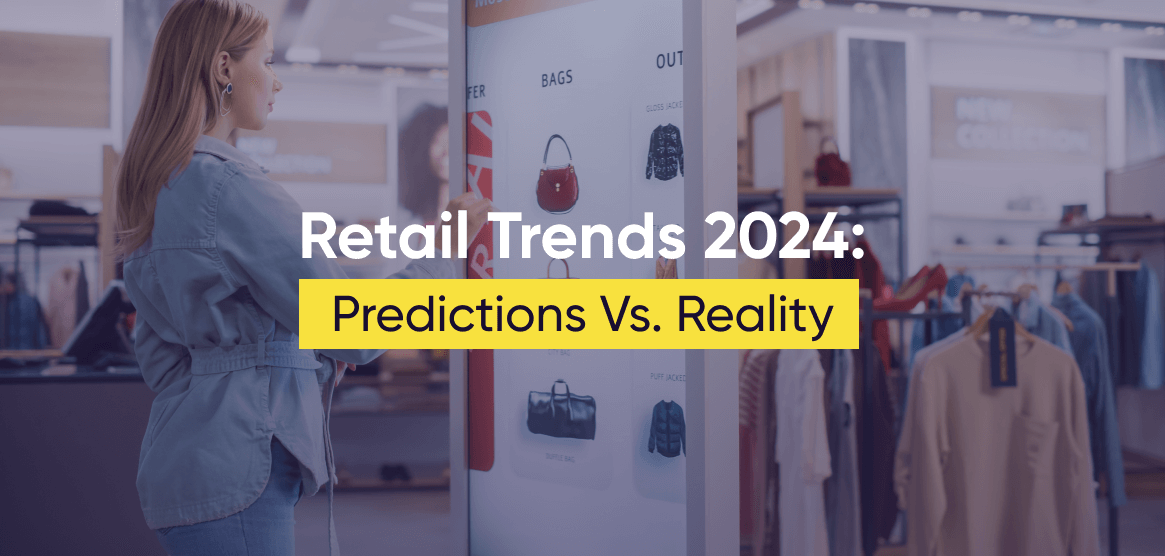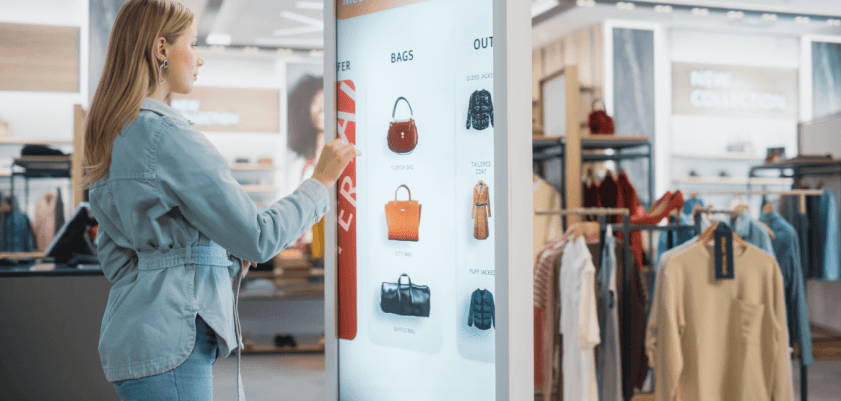In a vertical as diverse and fast-paced as retail, trend predictions often feel like a cross between magic and science. Think about it as a little bit of guesswork mixed with quite a bit of data. When it comes to retail trends in 2024, there are countless innovative solutions emerging. In today’s article, we will be looking at the future of retail in 2024, including retail media networks, resale growth, utilizing social commerce and payment options alike.
Are you also interested in current and future trends in loyalty strategies? Download our latest Global Customer Loyalty Report to learn experts’ and program owners’ perspectives on the loyalty landscape.
Trend #1: Digital Resale Growth – Where Values Meet Finances
Prediction: Customer habits will change and the second-hand market will expand due to a few different key factors (economic, environmental, personal) working in tandem. Resale sites have already experienced astronomical growth in the past few years and are predicted to continue to grow in the future. In fact, the global secondhand apparel market is forecasted to reach a whopping $350 billion in revenue by 2028.
Reality: Buying habits have significantly changed. More and more people are considering second-hand items both in the everyday and luxury market, looking for quality, value, and cost-effectiveness. Sites like ThredUp, DePop, Poshmark, eBay, and, on the luxury side, TheRealReal are experiencing an overflow of transactions, with the resale industry growing 7x faster than the broader retail clothing market.
The Reasons Behind Resale’s Rapid Growth
- Sustainability: Customers see the value in choosing a more sustainable option by purchasing pre-owned items instead of buying into fast-fashion trends.
- Affordability: With inflation and the general cost of living being through the roof, buying pre-owned items has become the only way for many people to keep up when it comes to everyday clothing.
- Earning by selling: Resale sites like Vinted (downloaded 32.8 million times in 2023) make it easy for users to declutter and sell unwanted items, which is a win-win situation for buyers, sellers, and the marketplace itself.
- No-buy / low-buy trends across social media: As overconsumption and the damage it causes become more apparent every day, many customers employ lifestyle changes. The result is that shoppers don’t buy new items for months at a time or even a year. The exception to the rule in many cases is buying pre-loved clothing.
Trend #2: Customer Feedback Brings Competitive Advantage – This Is Why You Should Listen to Your Audience
Prediction: Brands will start engaging with their customers like never before. Brands that use social media like a Swiss Army knife will come out on top. Just like the world-famous gadget, social media can be a powerful and multifaceted tool if used correctly.
Reality: In 2024, we can say with certainty that social media has established itself as not only a platform for brands to sell their products, but also a place that fuels their future growth, product development, and, last but not least, their reputation. Brands that learn to utilize it well, especially Social listening, are met with a goldmine of customer data.
The Perfect Example of Turning Criticism Into a Major Win
Let’s look at how Béis, the luggage brand, wields social media to its advantage. Founded by actress Shay Mitchell, the company has recently faced backlash on social media, where people complained about how quickly their products started to show wear and tear. Instead of turning a blind eye, the brand decided to face the issue head-on.
Béis decided to build a car wash-style pop-up establishment called Béis Wash, where customers could have their dirty luggage cleaned for free.
This venture was highly successful, resulting in thousands of new followers, merch sales, media exposure, and priceless WoM and PR. It shows how important it is to take responsibility and not just credit.
Trend #3: Social Commerce Still Going Strong – Shopping at Your Absolute Convenience
Prediction: Social media will be a lucrative avenue for the retail industry, allowing them to harness social proof, seamless integrations, and users’ tendency to switch from search engines to social platforms in the TOFU phase of the customer journey. Social commerce earnings are reportedly well on their way to hitting an astounding $80 billion by 2025, becoming one of the primary platforms for online purchases around the globe.
Reality: While site preference relies largely on generational differences, with Baby Boomers still favoring more old-school options like Facebook, and Gen-Z quickly adapting to newer options like TikTok Shop, it’s undeniable that social commerce has become a major force in retail worldwide. It has become so prevalent that it has become a challenger even for leading eCommerce sites like Amazon.
The Reasons Behind the Success of Social Commerce
- Convenience: Social commerce allows users to buy directly from the platform without having to visit a different website.
- Social proof: Users can immediately see likes, shares, comments, reviews, and ratings.
- Influence: Shoppers can get inspired, watch “how-it-works” videos, and immediately shop for the products recommended to them by their community or influencers.
- AR filters: Shoppers can use enhanced filters to instantly try on a product, taking both the “guessing game” and in-store hassle out of the picture.
Trend #4: Retail Media Networks Are Taking Over – Turning the Retail Advertisement World Upside Down
Prediction: Building upon the rapid growth of retail media networks in previous years, companies will streamline their operations, and more verticals will start offering similar services. According to recent data, the global retail media network market is on course to reach an estimated USD 7.3 Billion by 2032.
Reality: Retail media has become its own advertisement empire. It enables advertisers to target customers with personalized ads — using first-party data — much closer to the point of sale than any other form of advertisement. Retail Media Networks that currently offer these types of advertising channels to brands were brought to life by retail giants such as Amazon, Walmart, and Kroger. Moreover, other verticals are starting to adapt to the new model, with Marriott International leading the way with its Travel Media Network.
Why Retail Media Network Offerings Work So Well Both Online and In-Store
- Instead of casting a wider net for a bigger audience at the beginning of their buyers’ journey, targeting customers with clear buying intent enables brands to streamline budgets and optimize ROI.
- Personalized offerings have a much better chance of converting search into purchase.
- Allows brands to utilize the first-party data they’re losing as a result of recent privacy regulations.
- Website solutions include: sponsored products, sponsored brands, search ads, display ads, or email ads.
- In-store solutions include: displays, digital screens, Connected TV (CTV), email, and mobile push notifications.
Trend #5: Payment Method Innovations – “Easy Come, Easy Go” Is the Whole Point
Prediction: Constant innovation will be on retailer’s minds. This is especially true when it comes to online and offline payment options because they provide a frictionless and convenient shopping experience for all niches. Users are always ready and willing to experiment with new technologies, as long their criteria are met.
Reality: Answering the question “What do consumers want in 2024?” is rather simple: they want a safe, fast, and convenient way to shop. According to recent reports, industry-leader payment processors (Visa, Mastercard, J.P. Morgan) are ready to bring out the latest — and biggest — innovation in recent history: revolutionizing transactions using biometric technology. Soon, shoppers will be able to complete payments using their palm prints, fingerprints, or facial recognition. The technology is already being tested.
Some of the Most Significant Options on the Market Today Are
- BNPL: Buy Now Pay Later, a solution offered by companies Klarna and Affirm and used by retailers such as Adidas and Neiman Marcus.
- Prepaid cards: As an emerging trend in the retail landscape, prepaid cards will exceed $1 trillion in global transaction value in the not-so-distant future.
- Mobile Wallets: This tried-and-true solution continues to dominate the market, projected to account for 54% of eCommerce transaction volume by 2026.
How Loyalty Programs Support Innovation in Retail
The rapid growth of the online resale segment has brought forth a question that every saturated market must face sooner or later: ”How do I stand out from the crowd?”. A loyalty program is the perfect solution to acknowledge and reward your customers’ dedication, offer exclusive benefits like VIP in-store event invitations, and compensate sustainable actions with extra points.
Loyalty programs also offer the perfect omnichannel capabilities for retailers to connect online, mobile, and in-store experiences for a complete 360 personalized approach, recognizing, engaging, and rewarding customers at every touch point.
Plus, with a special emphasis on social media platforms, retailers are able to engage and activate an even wider audience segment, involving them in competitions and hashtag contests, or creating ambassador programs by employing elaborate tier systems.
Ready to learn more about what next-gen loyalty programs are capable of? All you have to do is request a demo session or send us an RFP for detailed answers.
And how are loyalty programs performing in the current market? Download our latest Global Customer Loyalty Report with expert insights on current and upcoming trends.
Zsuzsanna is a Loyalty Specialist and Certified Loyalty Expert™ with years of experience in digital marketing and e-commerce. Zsuzsanna is known for having an analytic approach and high-level communication skills, helping her deliver engaging content. In her free time, she enjoys watching Formula 1 and listening to endless Taylor Swift playlists.

